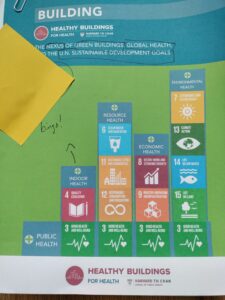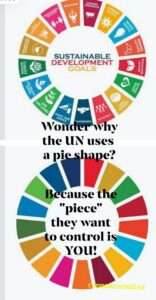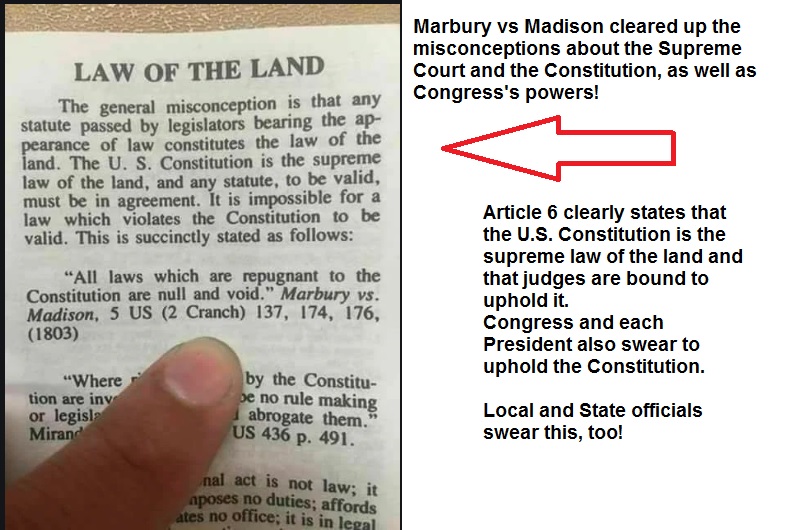Hello Warriors! March 2024 is here and not to miss a global beat so is a new report by Harvard University extolling the global virtues of aligning not only education in America, but everywhere else in the world there’s a school building! Oh, but wait, why stop at school buildings?
This report which is slam full of the UN’s SDGs (United Nations Sustainable Development Goals), goes into some detail as to why EVERY building that’s old is a literal danger to us all, while new, green building is the healthy solutions we all need…to be indoors. Chicken Little would be so proud of this.
Warriors, go to this link, then look to your right, at the bottom. The instant downloadable report you are seeking is titled, “Building for Health:
The Nexus of Green Buildings, Global Health, and U.N. Sustainable Development Goals”. If you look to the left, on the website, notice the vast network of building types Harvard has involved in this effort. Schools are among them. According to the school website page, the school buildings influence how students think, perform and are healthy. Wow, I thought it was the teachers and families of the students who influenced them.

From the Report, some key items you need to know:
1) Every one of the authors of this Report are tied to Harvard University and partners.
2) The Report is more about Climate Change Agenda than anything else. Health is used as widget of conformity. While there are buildings that are unsafe in air quality or not up to acceptable building standards, this Report is using the mindset of ‘throwing the baby out with the bathwater’ in assuming ALL old buildings are the harmful problems. (*Note: if you’re concerned about zoning and building construction and how those are being manipulated for the SDGs, read this article detailing the global building codes and then, please read this article.)
3) Five types of ‘public health and its connection to the SDGs are explored:
a) public health (foundation for 11 of the SDGs: 3 (health), 4 (education), 6 (clean water/sanitation), 7 (affordable clean energy), 8 (labor/jobs), 9 (industry, innovation, infrastructure), 11 (sustainable cities/communities), 12 (responsible consumption/production), 13 (climate action), 14 (life below water), and 15 (life on land)
b) indoor health (where you find schools and healthcare. It also includes 6, 7, 8, 9, 12, 13 and 15)
c) resource health (every type of service a building offers like water fountains, bathrooms, HVAC systems, windows, etc is impacted) By default, SDGs 6, 11 & 12 are the top ones, but will also impact 3, 4, 7 and 8)
d) economic health (directly connects to job performance and how well the work boosts the economy for all. SDGs 8 & 9 are most impacted, but SDGs 1 (no poverty; which isn’t mentioned in the report), 3 & 4 are impacted.
e) environmental health (basically everything outdoors will need to be conformed as well. The Report claims that the harmful greenhouse gases our present buildings give off is the upmost of harm to the global environment. The SDGs most involved are 7, 13, 14 & 15. Considering that schools should have playgrounds, this would automatically involve SDG 4.
4) Page 4 of the Report featured a quote by Winston Churchill about buildings shaping us. The authors took the liberty of distorting this concept to include the 5 types of health listed above. The suggestion of buildings constantly attacking us psychically and mentally for performance based output is very easy to see. Especially when it’s followed up with ‘existing buildings are the biggest threat to the environment and the biggest factor of climate change’.
5) Don’t miss, on page 5 the acknowledgement of when the MDGs (Millennium Development Goals) were shifted to the SDGs (2012). The person quoted, Jeffery Sachs is a leading SDG globalist. He’s also a professor and economic analyst. His point? Vigorous embracing of ‘green building’.
6) Page 6 boldly hinted that our past is so wrong that only the UN’s design for the future can help us.
Here’s a quote: “Urban growth will impact cities large and small, but the fastest growth will be seen in mid-sized cities of about 1 million people (UN 2014). Considering population growth together with rapid urbanization and that most people spend most of their time indoors (Kelpeis 2001) makes clear that buildings will have an outsized impact on health globally for decades to come.” (*Note: Warriors, do we need to be reminded that between the weather manipulation and the rack/stack/packing of humans these are direct results of the SDGs. So how can the SDGs harm us and hem us in on one hand, but save us on the other hand?) This isn’t about education or school buildings, my friends. This is about politically driven conformity.)
7) Page 11 is so full of educratic BS and horse hockey, it’s not even funny. Before you get to how SDG #4 is so vital to healthy buildings, this is stated:
“A robust body of research produced over 40 years on the importance of the indoor environment has revealed what we call the 9 Foundations of a Healthy Building: ventilation, thermal health, air quality, moisture, dust and pests, safety and security, water quality, noise and lighting.”
(*Note: thermal health is tied not so much to schools and education/learning, but jobs, labor and occupations. How long you are hot or cold impacts not only how well you think, but more importantly, how hard you work to produce a product. This paper from the US Dept of Health/Human Services via the National Institutes of Health lays it all out.) When you consider that page 11 is included one of the main pages discussing school buildings, it’s important to note that the focus isn’t on education: it’s on jobs. Another UN SDG way to tie quality education to decent jobs for all (ie: SDGs 4 & 8 respectively).
Here’s another quote from page 11 about education (SDG #4): “The influence of buildings on health is grossly apparent in schools, a focus of Goal 4. There are many facets to a high-quality education, of course, but the one that often gets ignored is the role of the building.” (*Note: lack of fresh air, sunshine and outdoor playtime are just as key to the influence of a child’s learning, but these are not mentioned whatsoever. This doesn’t even begin to address the push for more computer time or artificial intelligence and their drastic harmful effects. ) This 2023 report from MDPI featured the IME (International Medical Education) on how well students perform and thermal health. MDPI is a member of the UN’s Global Compact. IME is owned by the Academic Society for International Medical Education based in Japan. If you dig a bit deeper ASIME is connected to Nagoya University in Japan. Nagoya Univ. is a proud supporter of the UN’s SDGs.
What about PISA (Programme for International Student Assessment) these high stakes assessments, are used globally. ResearchGate has this information for you about the performance of students during testing and building temperatures. Here’s a quote about students (aka ‘human capital’ a term the OECD, Organization for Economic Cooperation and Development gave us). “Human capital generally, and cognitive skills specifically, play a crucial role in determining economic mobility and macroeconomic growth. While elevated temperatures have been shown to impair short-run cognitive performance, much less is known about whether heat exposure affects the rate of skill formation.” (you can view the image below in a larger format by opening it in a new window) This quote isn’t surprising when you access the link, above, for PISA. It’s from the OECD!
“Going Green” Schools, USA:
Thanks to our tax dollars being used against us, here in the US, the U.S. Dept. of Education has created a Green Ribbon Schools program.
Described as “The U.S. Department of Education Green Ribbon Schools (ED-GRS) is a public engagement initiative for school sustainability that is structured as a federal recognition award. By highlighting schools, districts, postsecondary institutions, and early learning centers’ cost-saving, health promoting, and performance-enhancing sustainability practices, ED-GRS celebrates these institutions and brings more attention to their work.”
The 3 pillars of Green Ribbon Schools are: 1) lower environmental impact and cost; 2) improve health and wellness; and, 3) effective environmental and sustainability education especially using STEM and 21st Century technology. (*Note: open the image below in a new window to see just how toxic the UN and STEM are in education, everywhere.)

The resource hub for the US Dept of Ed’s Green Ribbon Schools is known as ‘Green Strides’ and connects to the US Green Building Council.
The US Green Building Council information can be accessed here. USGBC’s mission: “Transforming buildings and communities to advance human and environmental well-being.” Happening in just a couple of days (March 6, 2024) is the Buildings and Climate Global Forum. USGBC will be presenting there. Of note, is the ‘decarbonization’ and ‘resilience’ of buildings.
The World Green Building Council information can be found here. Their mission? “The World Green Building Council (WorldGBC) catalyses the uptake of sustainable and decarbonised built environments for everyone, everywhere. We work with businesses, organisations and governments to deliver on the ambitions of the Paris Agreement and UN Global Goals for Sustainable Development.”
Global Green USA (part of Green Cross International), Thanks to Former USSR President Gorbachev:
If you’ve not heard of the Global Green Schools, you can find out about them here. The purpose isn’t so much about building green buildings as it is about influencing your students to adopt green thinking, green working, and greening everything in between. To say that this is an extension of the SDGs is an understatement of epic proportions. “Behavior Sustainability” is among the top creations of this global movement, based in the USA. Again, the agenda doesn’t stop at the borders of America. The projects going on reach everywhere. Check out them out, here.
The tie to the former President Gorbachev can be found here. He was one of the founders of Global Green. Joining him was Diane Meyer Simon. (*Note: when you access the Global Green homepage, notice the gloom and doom countdown clock.)
Simon’s former Alma Mater, Butler University (USA) received a financial gift (2020) in order to carry on the agenda items connected to the UN’s SDGs. Global GreenUSA is a member of the Earth Charter. The Earth Charter is connected to the United Nations by the current movement to created a UN Constitution. If you don’t know about that effort (which will render the US Constitution as null and void), go here. My portion begins about the 17:59 time stamp. The remarks on the UN Constitution begin about the 23:00 minute mark. The interview was continued the next evening, begin at the 17:44 time stamp.)

Here’s a quote from an instant downloadable document from the University of Geneva (Switzerland) from the 2008-009 Activity Report on GCI, “Climate change poses an increasing threat to global security and stability. Because it is the net result of several contributing factors, a matching response has to be comprehensive and systemic. Given the unprecedented scale of the climate and inter-related challenges and the urgency of global coordinated action, Green Cross provided a platform for a Task Force of opinion leaders, not linked to the negotiations process. The idea is to strengthen the global response process to climate change in a way that is fair, balanced and effective. Led by GCI Founding President Mikhail Gorbachev, the Climate Change Task Force (CCTF) had its inaugural meeting in Geneva on 5 October 2009, in the presence of United Nations Secretary-General Ban Ki-moon.” (*Note: ‘Opinion leaders’, not elected officials: driving an agenda based on personal opinions and passed off as international policy!)
US Dept of Housing and Urban Development:
Warriors, here’s a link that describes how, since 2016 HUD has been ‘greening’ America.What you may not realize is that the ‘green movement’ will attach to your taxes, your mortgage and your house insurance. So how long will it be, for those with older homes, to see the agenda push them out? HUD’s position on green public housing can be found here. This will incorporate ‘green communities’. On the global scale, the World Bank oversees urban development.Be sure to check out their ‘Thriving’ tab on the website.
Closing:
Warriors, I trust by now, you’ve seen that this isn’t really about school buildings or really, even healthy students. This is about conformity, compliance and utter dependence on a system which has been propped up, not so much by real science or real facts, but opinions, agenda items and narcissist leaders.
Yes, at one point in history, many of our buildings had lead paint, asbestos and other such health hazards. However, this ‘green building’ movement goes far beyond removing unhealthy elements from buildings. It’s the framework for indoor prisons. Think about some of the newer school buildings you see. They do NOT resemble a school as we know it.Please, share this article, not only in the US, but with your family and friends across the world. The pivotal point for us all is this: we don’t have to be conforming or compliant to the United Nations.




